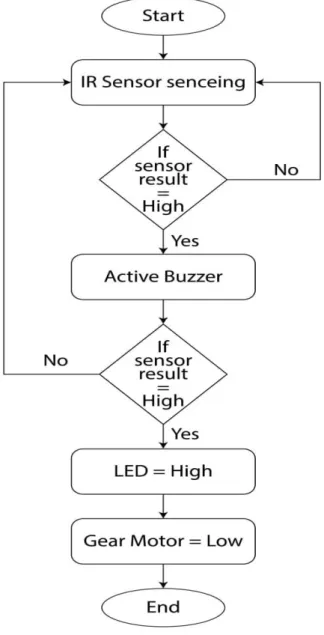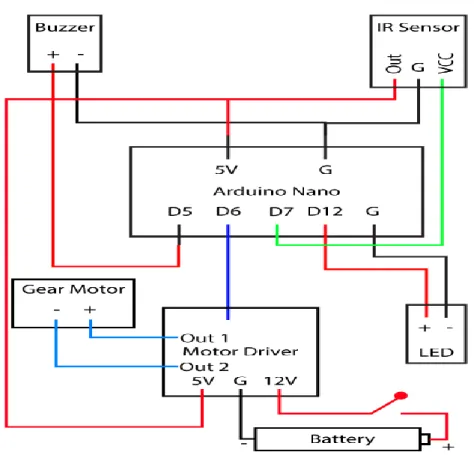For backlighting, another driver will understand that the vehicle will stop and thus we can reduce the number of accidents. This makes the driver active again and reduces the risk of accidents. If the driver does not open his eyes after the buzzer sounds, the LED light will open and the engine will stop automatically.
In this way, we can avoid many major accidents and many lives can be saved from danger.

Expected Outcomes
Our system is very easy to use and does not require complex maintenance and can be easily operated by anyone.
Project Management and Finance
Quality control: The implementation of processes and procedures to ensure that the anti-sleep alarm system meets the required standards for functionality, reliability and safety is essential to the success of the project. Managing the finances of the project may also involve tasks such as seeking funding or investment, tracking expenses and managing budgets to ensure the project stays within its financial constraints.
Report Layout
Conclusion: This section should summarize the main results of the project and provide any recommendations for further work or improvements. A well-organized project report will help to clearly communicate the results and outcomes of the anti-sleep alarm system development project and provide a useful reference for future work.
BACKGROUND
- Preliminaries/Terminologies
- Related Works
- Comparative Analysis
- Scope of the Problem
- Challenges
There are several different types of anti-sleep alarm systems available, In India we have found related work. One way to address this problem is through the use of a driver anti-drowsy alarm system. A comparative analysis of different driver anti-sleep alarm systems will involve examining the different technologies and approaches used by each system, as well as their effectiveness in detecting and preventing driver fatigue.
This can be a problem for drivers who work long hours or have irregular sleep schedules. The scope of a driver sleep prevention alarm system project would depend on the specific goals and objectives of the project. There are several challenges that can arise in the development and implementation of an alarm system to prevent driver drowsiness.
Sensing technology: One of the key challenges in developing an effective anti-sleep alarm system for the driver is accurately detecting when the driver is at risk of falling asleep. False alarms can be triggered by various factors, such as changes in lighting or the driver's facial expression. User Acceptance: For a driver anti-sleep alarm system to be effective, it must be used consistently by the driver.
Cost: Developing and implementing a drowsy alarm system can be expensive, as it requires the use of specialized sensors and software. Legal and Regulatory Issues: There may be legal and regulatory issues to consider when developing a driver sleep alert system.
REQUIEMENT SPECIFICATION
- Business Process Modeling
- Requirement Collection and Analysis
- Block Diagram and Description
- Logical Data Model
- Design Requirement
By modeling the business process in this way, it is possible to identify any bottlenecks or inefficiencies in the process and to develop strategies to improve system performance and efficiency. It can also help identify any potential conflicts or trade-offs that may need to be addressed in the design of the system. In the context of a driver anti-drowsy alarm system project, use case modeling could be used to identify the different ways the system can be used and to specify the steps and interactions involved in each use case.
A use case is a description of a specific scenario or interaction between a user (in this case, the driver) and the system. To create a use case model for a driver sleep alert system, the team would first identify the different types of users and the tasks they need to perform with the system. By modeling use cases in this way, it is possible to understand the requirements for the system in more detail and ensure that the system is designed to meet the needs of all the different users.
To create a logical data model for a driver anti-sleep alarm system, the team would need to identify the data entities relevant to the system and the relationships between them. The logical data model can be used to understand and organize the data used by the system and to design the database structure and schema that will be used for it. Safety: The system must not distract the driver or cause other safety issues while in use.
Confidentiality: The system should respect drivers' privacy and should not collect or transmit personal data without the driver's consent. Compliance: The system must comply with all relevant safety regulations or standards, such as those governing the use of electronic equipment in vehicles.

DESIGN SPECIFICATION
- Front-end Design
- Back-end Design
- Interaction design and user experience (UX)
- Implementation Requirements
Don't forget to consider the aesthetics of the device as well and make sure it matches the overall design of the vehicle. Consider how long the device should be able to operate without charging or replacing. When designing the background, don't forget to consider the reliability, security and maintenance requirements of the device.
Ease of use: The device should be easy to use, with clear and intuitive controls. The driver should not spend a lot of time figuring out how to use the device. Integration: The device must be easily integrated into the vehicle's existing controls and display system.
The driver would not have to spend a lot of time figuring out how to use the device in conjunction with other systems in the vehicle. Aesthetics: The device should look attractive and match the overall design of the vehicle. Data storage: If the device needs to store knowledge, such as detector readings or alert history, you will need to consider how to store that knowledge and how to access it as needed.
Connectivity: If the device needs to connect to alternative systems, such as a vehicle's on-board diagnostic system or a smartphone app, you will need to think about what feature you need and therefore the best credit for its implementation. Testing: You will be forced to test the device to make sure it is reliable, accurate and meets the user's wishes.
IMPLEMENTATION AND TESTING
- Implementation of Database
- Implementation Front end Design
- Developing the visual design: The next step is to develop the visual design of the UI, which includes the color scheme, typography, and other aesthetic
- Testing Implementation
- Unit testing: Unit testing involves testing individual components or units of the system to ensure that they are working correctly. This might involve testing the
- Integration testing: Integration testing involves testing the system as a whole to ensure that all of the different components are working together correctly
- User acceptance testing: User acceptance testing (UAT) involves testing the system with actual users to ensure that it is easy to use and meets the needs of the
- Performance testing: Performance testing involves testing the system to ensure that it is able to handle the expected load and usage patterns without
- Test Results and Reports
- Test case results: action results give information on the end result of individual take a look at cases, as well as whether or not the take a look at passed
- Test outline reports: take a look at outline reports give an outline of the results of the testing method, as well as the quantity of take a look at cases that
- Test execution reports: take a look at execution reports give elaborate info on the execution of the tests, as well as the steps that were taken, the expected
- Test incident reports: take a look at incident reports document any problems or bugs that were encountered throughout testing, as well as the steps that were
This should be done in a way that is consistent with the overall brand identity of the system and is visually appealing and easy to read. This may involve performing usability tests with real users or using automated testing tools to identify any issues or bugs. By implementing the front-end design in this way, it is possible to create a user interface that is intuitive, visually appealing and easy to use for drivers.
Testing is an essential step in deploying an anti-drowsy alarm system as it helps to ensure that the system is reliable, accurate and effective. This may include testing facial recognition sensors or software used to detect driver fatigue, or testing database or other back-end systems. This may include conducting usability testing with drivers or other stakeholders to gather feedback on the system.
This may include testing the system under different load conditions or simulating high-traffic scenarios. By conducting thorough testing during the implementation phase, potential problems or bugs in the system can be identified and fixed before it is deployed, which can help ensure that it is reliable and effective in the field. Test results and area unit reports are a very important part of the testing method in implementing a driver sleep warning device.
Test results and reports are critical to understanding the performance and irresponsibility of the system.

IMPACT ON SOCIETY, ENVIRONMENT AND SUSTAINABILITY
- Impact on society
- Impact on Environment
- Ethical Aspects
- Sustainability Plan
It is important to ensure that any system developed respects the privacy of drivers and that the data collected by the system is only used for the purpose of improving road safety. Another ethical consideration is the potential for the system to create an expectation that drivers must always be awake and alert while driving. It is important to ensure that the system is not used in a way that undermines the autonomy or dignity of drivers.
In general, the ethical aspects of a driver sleep warning system should be carefully considered in order to ensure that the system is developed and implemented in a way that respects the rights and well-being of drivers. A sustainability plan for a driver sleep warning system should consider the environmental, social and economic impacts of the system. From an environmental perspective, the sustainability plan should consider the potential impact of the system on greenhouse gas emissions, air quality, and other environmental factors.
This may include designing the system to be as energy efficient as possible, using materials that are environmentally friendly and sustainable, and implementing measures to reduce the system's impact on the environment. From a social perspective, the sustainability plan should consider the impact of the system on the well-being and safety of drivers. This may include designing the system to be as unobtrusive as possible and ensuring that it does not create an expectation that drivers must always be alert and alert while driving.
From an economic perspective, the sustainability plan should take into account the long-term economic viability of the system. Overall, a sustainability plan for an anti-drowsy driver alarm system should take into account the environmental, social and economic impacts of the system and implement measures to ensure that the system is sustainable in the long term.
CONCLUSION AND FUTURE SCOPE
Discussion and Conclusion
Scope for Further Developments